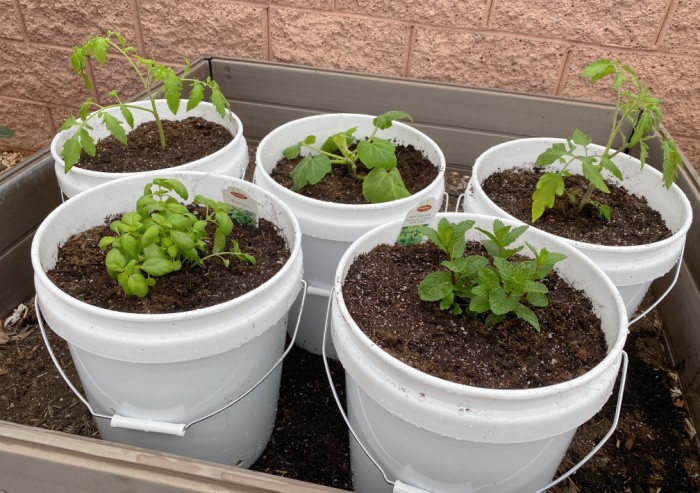
Today it’s all about how to garden with 5-gallon buckets. Here’s the deal, we can’t all have 1-20 acres of land, right? Some of us have postage stamps lots like me, some have a porch and some have a balcony. But I’ll bet we all love picking those fresh sweet tomatoes in the summer. If you have ever had a garden, big or small, that first red tomato is gold, my friends. Maybe not worth as much as gold, but oh my gosh, I can smell the bacon cooking right now to go with those tomatoes to make the very best BLT!
In my neighborhood, very few people have a garden. In my humble opinion, I’m not sure they love to garden as much as I do. I love getting my hands on the earth and experimenting with what I can grow in the desert. The good thing about living in Southern Utah I can have two gardens if I plan ahead. I start seedlings inside while my garden is coming to an end outside. Now, I also have to cover the tomatoes with garden shade cloth to help modify the temperatures. This is the product I have used, Garden Shade Cloth. With that being said, I think it’s important to grow your own food whether inside, in a yard, in a bucket, or in a raised garden bed.
Updating Post Today
I’m updating this post today because as you know I have moved to Northern Utah where it’s much cooler. We are getting closer to getting our home permit to build but gardening may be put on hold once again. This is so frustrating to me because I love to garden and harvest fresh food daily. It’s been rough waiting and the price of food continues to rise. When I go to the grocery store I’m shocked each time I see the prices of eggs, milk (if you can get them), and of course meat.
I will be visiting the Farmer’s Markets this year to get homegrown veggies and fruits. Life is so good!
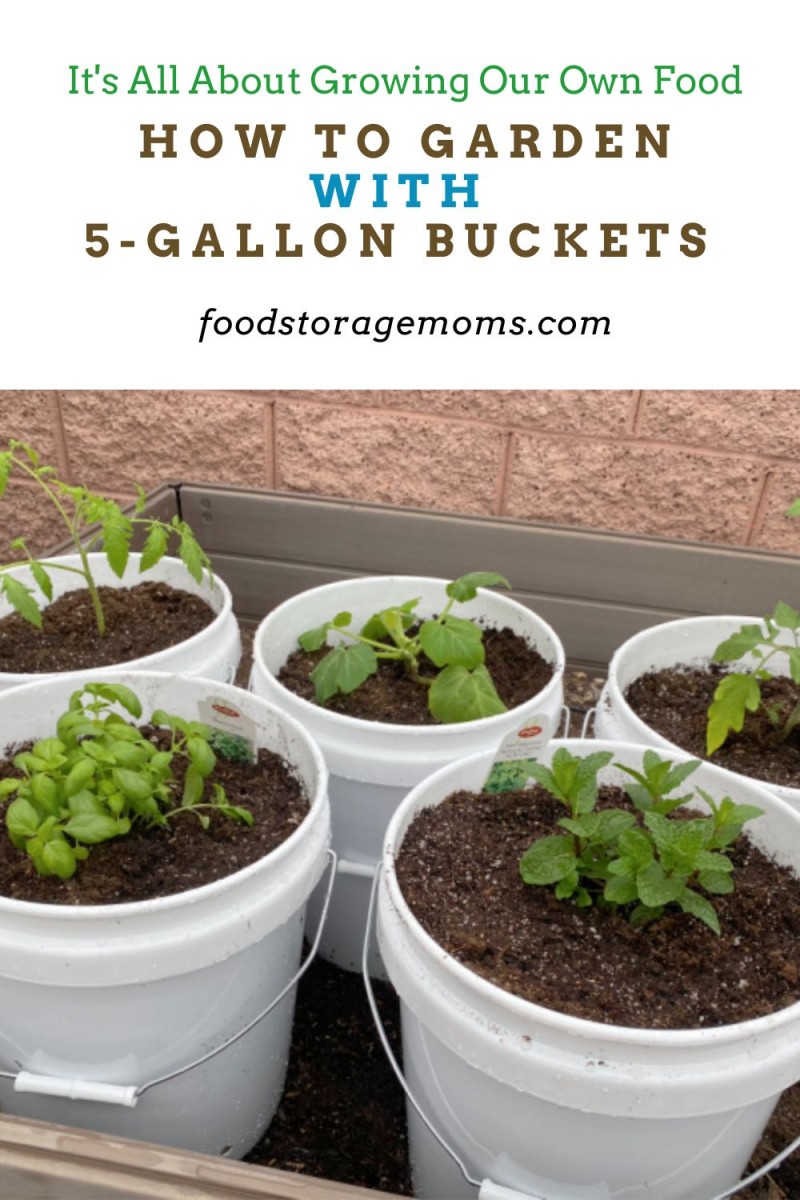
Why Plant Fruit and Vegetables in 5-Gallon Buckets?
You may be thinking, what in the world, why would I use a 5-gallon bucket to garden? Well, besides not having the space for an outdoor garden, there are a variety of benefits to using 5-gallon buckets. Here are just a few:
- You don’t need a huge backyard. You can grow food whether you have a backyard or not. In fact, you can even set these buckets right on your front porch or deck.
- It saves space. You still get plenty of food, but the buckets save space in your yard or another growing spot.
- Plants don’t get trampled. I don’t know about you, but when I had little ones running around, someone would seem to always trample something.
- They prevent rabbits and other small animals from eating your food. Although they could probably figure out how to get up in your plants, having them higher than ground level deters quite a bit of nibbling.
- No poor soil. When you put plants in a bucket, you know the soil is good for growing. And, you don’t have to deal with nasty weeds.
- The buckets are portable. If you notice your tomato plants are not getting enough sun, you can simply pick the bucket up and move it to a better location.
5-Gallon Bucket Gardening Cons
As stated above, there are a lot of benefits to gardening using a 5-gallon bucket. However, I do think it is important to note that there are also a few cons. Because the plants are in buckets, you may have to do more than you would if they were planted in the ground. Here are the few cons that I found to bucket gardening:
- You have to water more often. Make sure you water your plants regularly. The roots can’t dig into the ground to find more water if they are thirsty.
- The soil has to be replenished and amended. The soil in the bucket can’t replenish its nutrients as it would be able to in the ground. Each time you plant new plants, you will need to replenish and amend the soil with nutrients.
- There’s a cost to materials. Obviously, you may need to buy seeds to grow a garden anywhere, but buckets, it costs a bit more than just planting in your yard due to the cost of the buckets and the purchased soil.
How to Garden With 5-Gallon Buckets
Not everyone has a plot of land they can use to plant a garden. With that being said, there are plenty of ways you can still grow your own food! Instead of digging up your yard, you can use 5-gallon buckets to plant a variety of plants.
Items You Will Need:
- 5-Gallon Buckets (food grade and BPA-Free)
- A drill with a 1/2-inch drill bit
- Gravel or small rocks called marble chips (I bought what was on sale at Home Depot)
- Potting Soil (I bought what was recommended for pots/containers)
- Plants, seeds, or seedlings
- Vermiculate (Regulates soil PH value and temperature of the soil)
Step One: Purchase Your 5-Gallon Buckets – BPA Free
Mark and I picked up five 5-gallon buckets at a local grocery store. They were in the paint department and priced at $2.99 each. I made sure they were BPA-Free and food-grade. I didn’t need the lids, so that saved me a dollar or so.
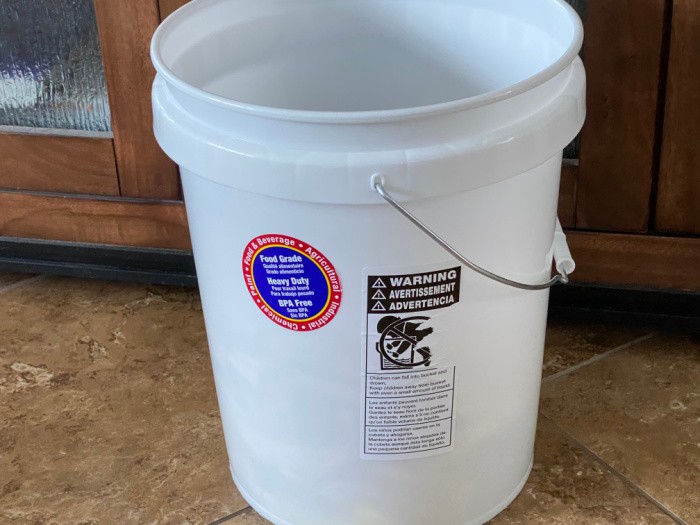
Step Two: Drill Four Holes in the Bottom for Drainage
We used a 1/2-inch drill bit to make four holes in the bottom of each bucket so the plants can drain after being watered. We just randomly drilled them, with no specific spacing.
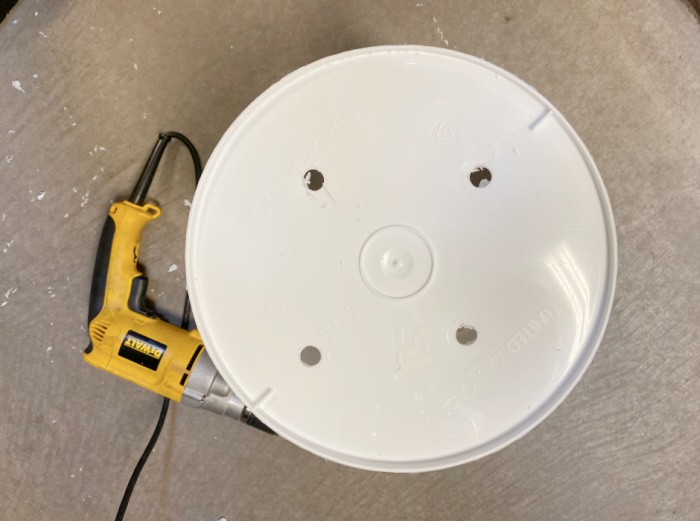
Step Three: Drill Additional Holes Around the Sides
Mark drilled four holes around the sides of the buckets (about 1-2 inches) from the bottom of each one to help circulate air within each container. We had to use some pliers to break off some of the plastic residues after drilling them.
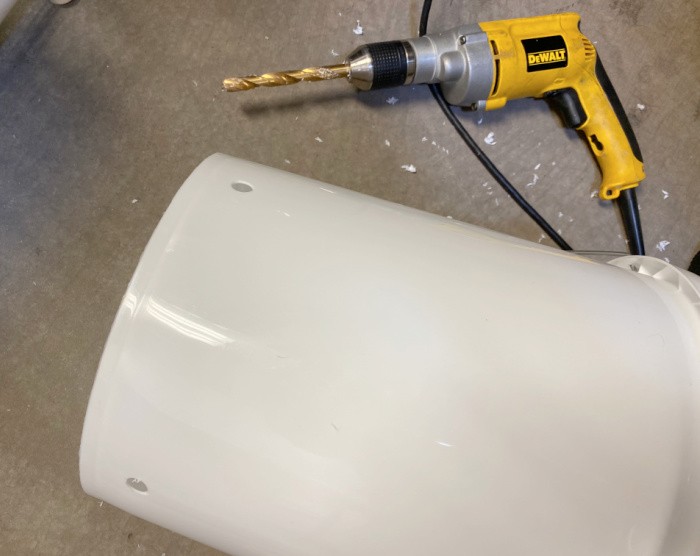
Step Four: Put Gravel or Small Rocks in the Buckets
When I went to find gravel, I couldn’t find any in a small quantity, so I opted for small rocks called marble chips. You need to fill each bucket with 2-3 inches of gravel, or in my case small rocks. To be honest, I didn’t want small gravel, I was afraid it would fall out of my 1/2-inch drilled holes.
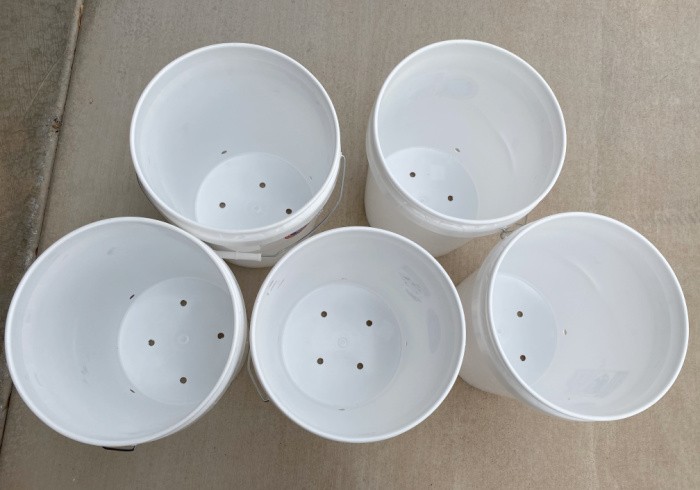
Step Five: Level Out the Gravel/Small Rocks
We put about 3 inches of rock (small rocks) in each 5-gallon bucket for proper drainage before we added the soil.
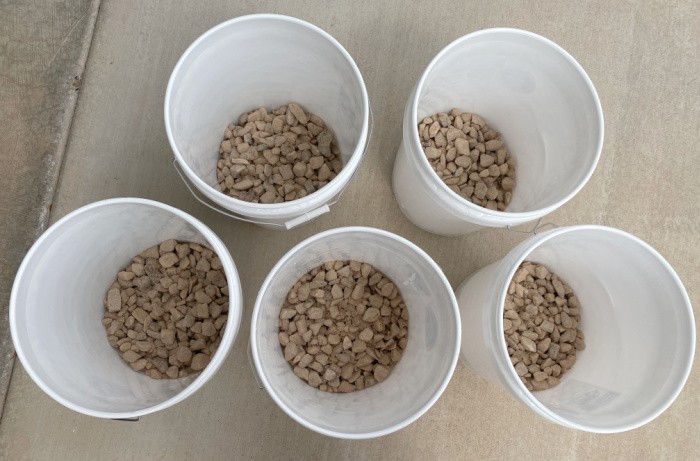
Step Six: Use Quality Potting Soil
This is the soil I purchased because it’s made by Dr. Q, a company I’ve had a good experience with, and it’s made specifically for containers. It’s organic and is formulated for planting in containers.
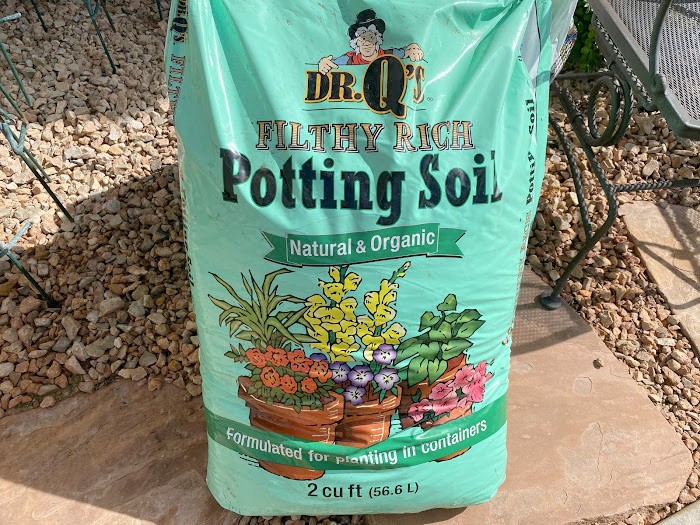
Step Seven: Fill Buckets with the Potting Soil
After filling the buckets with the rocks we purchased we filled the 5-gallon buckets with the soil shown above.
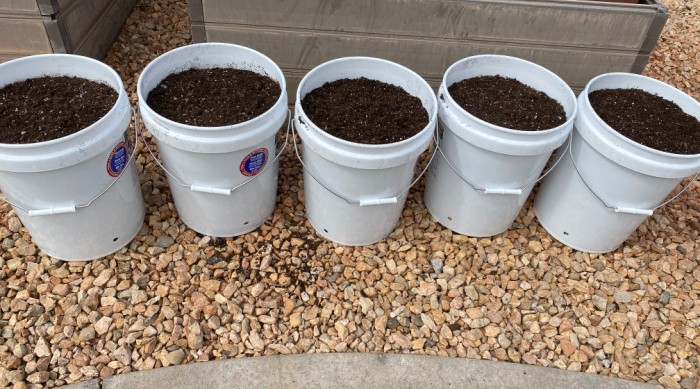
Step 8: Plant Your Seeds, Seedlings, or More Mature Plants
After you have set up your 5-gallon bucket, you can plant your seeds, seedlings, or plants into the buckets.
Why Do You Drill Holes in The 5-Gallon Bucket?
Don’t skip over drilling holes in your bucket. If you don’t drill holes, you may end up with dead plants. The holes help to protect your plants from water pooling up into the roots, especially during hard rains or excessive watering. If there is too much water from the roots, they can rot. Additionally, the plant won’t get enough oxygen and nutrients from the soil.
What Food Grows Well in 5-gallon buckets?
Unfortunately, not everything you may want to plant will grow well in a 5-gallon bucket. Below, I will give you a list of what foods you can grow in your buckets and how many of each you should plant per bucket:
- Tomatoes. You can plant cherry or bush tomatoes as they work best. Keep in mind, you only want to plant 1 tomato plant per bucket to prevent overcrowding. Update: I must say tomatoes are the hardest ones to grow in buckets or pots. You will need more Vermiculate and have to do more watering each day. I lived in the desert where the summer temperatures would reach 115 degrees mid-summer. I used shades to lower the temperature a little but they need a lot of water because the buckets dry out quickly.
- Cucumbers. Cucumbers are great to grow since you can eat them in salads, pickle them, or just enjoy them with some ranch dressing. Plant only 1 plant per bucket.
- Melons. I love a good watermelon. These get rather big, so, you will only want to put 1 plant per bucket.
- Squash. You can do all kinds of things with fresh squash. It grows well in a bucket, but you can only plant 1 plant per bucket.
- Eggplant. This is another one in that you can only put one plant per bucket.
- Peppers. Whether it’s hot pepper or bell peppers, only plant 2 plants per bucket.
- Beans. The best kind of beans to plant in a bucket are Bush beans. You can plant 3 plants per bucket.
- Onions. Not only are onions a good source of nutrition, but they can get expensive to buy all the time. You can plant 4 of them per bucket.
- Lettuce. We all need those leafy greens. You can plant 4 per bucket.
- Carrots. Great for your eyes and perfect as snacks, you can plant 10 carrots per bucket.
- Radishes. I love radishes on a salad. Plant radishes 10 Per bucket.
- Herbs. You can plant many different kinds of herbs in your bucket. One herb plant will spread and fill the entire bucket.
This is where I buy all of my garden seeds: SeedsNow.
5-Gallon Bucket Gardening Tips and Tricks
This gardening method is pretty straightforward, but along the way, you always learn a few tips and tricks. Here are a few tips and tricks to keep in mind when using 5-gallon buckets for gardening:
- Companion plants. Companion plants are beneficial and can help keep nasty bugs away while attracting good ones.
- Give the buckets a twist every week. Giving the buckets a quarter twist each week helps plants not to grow lopsided since they love to seek out the sun.
- Insecticides. You can combine four to five tablespoons of concentrated dish soap with one gallon of water to make insecticide. Mix it well and use a spray bottle to apply.
- You can reuse your potting mix. Amend it and replace it with fresh ingredients once per year, remove dead plants, and shake loose soil from roots. Fill it back up and use it again.
Seeds or Live Plants?
What is best to plant in your buckets, seeds, or live plants? I have used seeds, but many have said that live plants thrive best in buckets. If you don’t have a green thumb, I would suggest buying live plants. Today, I planted plants from the nursery. My seedlings are not big enough for a “picture” yet, Lol! I needed to get this post up for all to see. So many people don’t have access to land, so here they are! I will be covering them tonight with domes to protect them from rain or frost.
Other Posts to Read
There are so many vegetables you can grow outdoors, depending on where you live. Check out my posts on what to plant each month of the year!
- What To Plant In January
- What To Plant In February
- What To Plant In March
- What To Plant In April
- What To Plant In May
- What To Plant In June
- What To Plant In July
- What To Plant In August
- What To Plant In September
- What To Plant In October
Garden Gloves
These are my favorite garden gloves: DIGZ Garden Gloves. They come in different sizes, that’s what I love the most. These are the best rose bush gloves: DIGZ Rose Bush Garden Gloves I have to get a large size for my hands. These are awesome! In case you missed this post, Container Gardens: Everything You Need To Know
Final Word
I hope you enjoyed my post today on how to garden with 5-gallon buckets. I love growing a majority of my food, and I bet you would like to! Life is good if we live and learn to work through issues growing fruits and vegetables. If you have a Farmer’s Market near you, you are so lucky! Let’s grow as much food as we can, we can do it! May God Bless this world, Linda
The post How to Garden With 5-Gallon Buckets appeared first on Food Storage Moms.
